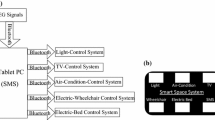Abstract
A novel non-contact controller of the electric bed for medical healthcare was proposed in this study. Nowadays, the electric beds are widely used for hospitals and home-care, and the conventional control method of the electric beds usually involves in the manual operation. However, it is more difficult for the disabled and bedridden patients, who might totally depend on others, to operate the conventional electric beds by themselves. Different from the current controlling method, the proposed system provides a new concept of controlling the electric bed via visual stimuli, without manual operation. The disabled patients could operate the electric bed by focusing on the control icons of a visual stimulus tablet in the proposed system. Besides, a wearable and wireless EEG acquisition module was also implemented to monitor the EEG signals of patients. The experimental results showed that the proposed system successfully measured and extracted the EEG features related to visual stimuli, and the disabled patients could operate the adjustable function of the electric bed by themselves to effectively reduce the long-term care burden.







Similar content being viewed by others
References
Allison BZ, Luth T, Valbuena D, Teymourian A, Volosyak I, Graeser A (2010) BCI demographics: how many (and what kinds of) people can use an SSVEP BCI? IEEE Trans Neural Syst Rehabil 18(2):107–116
Barea R, Boquete L, Mazo M, Lopez E (2002) System for assisted mobility using eye movements based on electrooculography. IEEE Trans Neural Syst Rehabil 10(4):209–218
Bi L, Fang X, Jie K, Teng T, Ding H, Liu Y (2013) Using a head-up display-based steady-state visually evoked potential brain-computer interface to control a simulated vehicle. IEEE Trans Intell Transp Syst 15(3):959–966
Cecotti H (2010) A self-paced and calibration-less SSVEP-based brain–computer interface speller. IEEE Trans Neural Syst Rehabil 18(2):127–133
Gollee H, Volosyak I, McLachlan AJ, Hunt KJ (2010) An SSVEP-based brain–computer interface for the control of functional electrical stimulation. IEEE Trans Biomed Eng 57(8):1847–1855
Horki P, Solis-Escalante T, Neuper C, Muller-Putz G (2011) Combined motor imagery and SSVEP based BCI control of a 2 DoF artificial upper limb. Med Biol Eng Comput 49(5):567–577
Jin J, Allison BZ, Sellers EW, Brunner C, Horki P, Wang X, Neuper C (2011) Optimized stimulus presentation patterns for an event-related potential EEG-based brain-computer interface. Med Biol Eng Comput 49(2):181–191
Lian S, Hu W, Wang K (2014) Automatic user state recognition for hand gesture based low-cost television control system. IEEE Trans Consum Electr 60(1):107–115
Licsar A, Sziranyi T (2005) User-adaptive hand gesture recognition system with interactive training. Image Vis Comput 23(12):1102–1114
Martinez-Millana A, Fico G, Fernandez-Llatas C, Traver V (2015) Performance assessment of a closed-loop system for diabetes management. Med Biol Eng Comput 53(12):1295–1303
Middendort M, McMillan G, Calhoun G, Jones KS (2000) Brain–computer interfaces based on the steady state visual-evoked response. IEEE Trans Rehabil Eng 8(2):211–214
Miller GE, Brown TE, Randolph WR (1985) Voice controller for wheelchairs. Med Biol Eng Comput 23(6):597–600
Müller-Putz GR, Eder E, Wriessnegger SC, Pfurtscheller G (2008) Comparison of DFT and lock- in amplifier features and search for optimal electrode positions in SSVEP-based BCI. J Neurosci Meth 168(1):174–181
Muller-Putz GR, Pfurtscheller G (2007) Control of an electrical prosthesis with an SSVEP-based BCI. IEEE Trans Biomed Eng 55(1):361–364
Pan ST, Li XY (2012) An FPGA-based embedded robust speech recognition system design by combining empirical mode decomposition and a genetic algorithm. IEEE Trans Instrum Meas 61(9):2560–2572
Park SA, Hwang HJ, Lim JH, Choi JH, Jung HK, Im CH (2013) Evaluation of feature extraction methods for EEG-based brain-computer interfaces in terms of robustness to slight changes in electrode locations. Med Biol Eng Comput 51(5):571–579
Pfurtscheller G, Solis-Escalante T, Ortner R, Linortner P (2010) Self-paced operation of an SSVEP-Based orthosis with and without an imagery-based “brain-switch:” a feasibility study towards a hybrid BCI. IEEE Trans Neural Syst Rehabil 18(4):1534–4320
Shyu KK, Chiu YJ, Lee PL, Liang JM, Peng SH (2013) Adaptive SSVEP-based BCI system with frequency and pulse duty-cycle stimuli tuning design. IEEE Trans Neural Syst Rehabil 21(5):697–703
Shyu KK, Lee PL, Lee MH, Lin MH, Lai RJ, Chiu YJ (2010) Development of a low-cost FPGA-based SSVEP BCI multimedia control system. IEEE Trans Biomed Circ Syst 4(2):125–132
Trejo LJ, Rosipal R, Matthews B (2006) Brain-computer interfaces for 1-D and 2-D cursor control: designs using volitional control of the EEG spectrum or steady-state visual evoked potentials. IEEE Trans Neural Syst Rehabil 14(2):225–229
Wang Y, Gao X, Hong B, Jia C, Gao S (2008) Brain–computer interfaces based on visual evoked potentials. IEEE Eng Med Biol 27(5):64–71
Wolpaw JR, Ramoser H, McFarland DJ, Pfurtscheller G (1998) EEG-based communication: improved accuracy by response verification. IEEE Rehabil Eng 6(3):326–333
Zhu Z, Ji Q (2007) Novel eye gaze tracking techniques under natural head movement. IEEE Trans Biomed Eng 54(12):2246–2260
Author information
Authors and Affiliations
Corresponding author
Rights and permissions
About this article
Cite this article
Lo, CC., Tsai, SH. & Lin, BS. Novel non-contact control system of electric bed for medical healthcare. Med Biol Eng Comput 55, 517–526 (2017). https://doi.org/10.1007/s11517-016-1533-6
Received:
Accepted:
Published:
Issue Date:
DOI: https://doi.org/10.1007/s11517-016-1533-6




